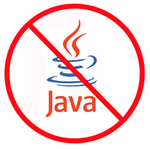I thought about why managing printing in an enterprise is so frustrating and came to a conclusion that the solutions available (and available to my budget) do not fill end users requirements but IT administrators requirements. Ultimately users what to print something, to the closest printer without having to install printers/drivers or speak to IT, where as IT administrators want to control deployment, configure default settings and centrally control access.
Windows
Deploying Java 7 JRE – Deep Dive! (Part 2)
Welcome to Part 2 of my series of Deploying Java 7 JRE – Deep Dive!
Hopefully my first article, Deploying Java 7 JRE – Deep Dive! (Part 1) has helped you understand the history behind what Java have been doing over the past year and how all these changes will affect you. This part will cover the steps to successfully overcome the deployment of Java in an enterprise. So lets get into it!
Deploying Java 7 JRE – Deep Dive! (Part 1)
 We have all had troubles with Java and quite frankly its been a challenge to keep up with all the changes. Between Java 7 Update 10 through to update 45 there have been changes in features and functions that affect how IT administrators deploy the software in an enterprise, let alone general software functionality (wont be covering that). I think the best outcome of all of this is Oracle’s commitment to supporting enterprise deployments of Java.
We have all had troubles with Java and quite frankly its been a challenge to keep up with all the changes. Between Java 7 Update 10 through to update 45 there have been changes in features and functions that affect how IT administrators deploy the software in an enterprise, let alone general software functionality (wont be covering that). I think the best outcome of all of this is Oracle’s commitment to supporting enterprise deployments of Java.
Migrating DHCP from Windows 2003 to Windows 2012 and setting up failover: Part 1
![]() The principles of DHCP are simple and Microsoft has not changed its core since before Windows NT days, however its not something you shouldn’t undertake lightly or ill-prepared. Most of your client devices will rely on DHCP to function and failing to migrate seamlessly will only cause disruptions to your business.
The principles of DHCP are simple and Microsoft has not changed its core since before Windows NT days, however its not something you shouldn’t undertake lightly or ill-prepared. Most of your client devices will rely on DHCP to function and failing to migrate seamlessly will only cause disruptions to your business.
This article is to help document how to migrate multiple active DHCP servers to a new DHCP server running on Windows Server 2012. We will finalise the configuration by creating a failover for all scopes to a secondary server. I am writing the to include all the necessary information that I think is required to complete this successfully.
Decomission a Windows 2003 or 2008 Domain Controller
To decommission an Active Directory Domain Controller (Windows Server 2003/2008) is a fairly straightforward task so long as you make sure nothing is relying on that server specifically. I will cover off the demotions steps (fairly easy) but I will go through a checklist (and how-to) of gotchas that you might get caught out when doing this.
UPDATE: 27/09/2019 – Quick update to say that this is definitely the most popular comment on my blog. Thank you all for the all the comments, and please do keep them coming. The more comments i get, the more likely i will start to write articles again.
Computer name conventions
Computer naming conventions are like creating an Active Directory hierarchy – there is no wrong or right. Its more about what best suits your current and future needs. Over the years my naming conventions have evolved and below I will document my currently preferred method. First we will look at the technical constraints when naming them, and what characters I recommend using.
How to configure a KMS server in Windows Server 2008 R2
Well I have had the pleasure of setting up a KMS server in our environment, and found that the documentation from Microsoft is somewhat confusing. In light of this I will write the steps I used to configure the first KMS server in our organisation for use with Windows Server, Windows client and Microsoft Office activation. These steps will only include the installation of 1 KMS server.
Who on your network is a Local Admin?
So I wanted an answer to a very simple question. Who on my network has been given Local Admin rights?
We have had requirements in the past where users had to be administrators for whatever reason, usually due to applications not working. Now i want to get a better understanding of who has access so we can try and minimise this (as I find it to be a security risk).
I did some searching around and it looks like i have found the a very simple solution. In short its a simple 2 line script that checks domain users (other than Domain Admins) and saves them in a file called %computername%.txt. It then searches that file for the user names and creates a new file for each user name in a different file called %username%.txt.
How to view log files in Windows Explorer preview pane
Have you ever had to look at alot of little log files and want to quickly glance at them? Well the easiest way to do this would be to use the Preview Pane in Windows 7 Explorer window. To enable this you need to add the following registry key: [code]Windows Registry Editor Version 5.00 [HKEY_CLASSES_ROOT\.log] … Read more